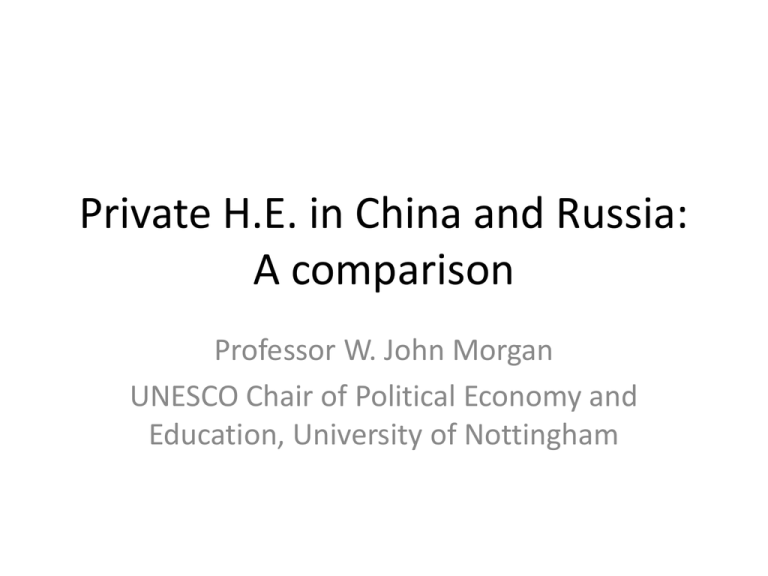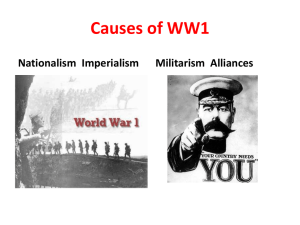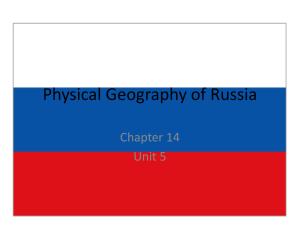Private H.E. in China and Russia: A comparison
advertisement

Private H.E. in China and Russia: A comparison Professor W. John Morgan UNESCO Chair of Political Economy and Education, University of Nottingham Private Higher Education • The growth of Private Higher Education should be seen as part of the diversification of provision in recent years. Hitherto, the state held a near monopoly on tertiary education. • That said PHE is a common feature of provision in North America and in Japan, while it is less wellestablished in Western Europe. • It is particularly evident in countries where higher education provision is experiencing contextual change or is still relatively undeveloped as a system. Private Higher Education • The economic crises and structural adjustment programmes of the 1980s challenged state dominance and markets were encouraged, in higher education as elsewhere in public policy. • This is shown by two trends:• The privatization of public institutions. • The emergence of private institutions. Private Higher Education • The former means the use of market principles in the operation of public institutions. • This takes the form of:• Cost recovery or cost sharing through fees. • Cost recovery of support services through contracting out. • Subsidizing the core teaching function • The development of the corporate university. Private Higher Education • The latter means the emergence of a nonstate sector. The institutions within this take different forms:• Partially state-supported institutions e.g. Buckingham in the UK. • Not for profit institutions often with large endowments e.g. Harvard and Waseda. • Faith-based institutions e.g. Notre Dame, Baptist U, Soka University, Gaza Islamic. Private Higher Education • The Roman Catholic Church is active globally outside the Islamic countries and Islamic organizations in countries such as Egypt, Indonesia and Malaysia. • For-profit institutions, some of which are run by corporations and trade stocks and shares e.g. Phoenix University. They are common in developing countries, are fee dependent, teaching market-friendly courses, rarely engage in research, and have major quality assurance issues. Private Higher Education • Private higher education is growing and is increasing its share of the total student enrolment. • Private higher education is often cross-border and sometimes a hybrid with public institutions in host countries. • Well-known public universities operate branch campuses under regulations applicable to private institutions in the host country e.g. Royal Melbourne Institute in Vietnam and Nottingham in Malaysia and China. Private Higher Education in China • This is a rather complicated field of practice usually called Ming-ban higher education and there is no consensus in China on a definition. • Today I will focus on for-profit institutions. • Before 1980 there were no private universities or colleges in China; by 1999 there were 43 private degree granting universities or colleges and more than 1,000 other institutions; by 2006 the number of degree granting institutions had increased to 278. Private Higher Education in China • Such institutions are found in well-developed areas of China. The reasons are obvious:• First, there is more investment available. • Secondly, local governments have an incentive to give their encouragement. • Thirdly, there is a strong public education system on which private HE can draw e.g. part-time staff. • Finally, there are more potential fee-paying students. Private Higher Education in China • There are some fundamental differences between Chinese private HE and its Western counterparts:• Investment is favoured over endowments. • Entrepreneurs expect economic returns when they invest. • Compared with public HE it has a poor social reputation while tuition costs are higher. • With expansion, social stratification has risen. Private Higher Education in China • A tiered system of higher education is emerging in China of which private HE is a part. This has consequences for social stratification in China. • Although a private not-for profit Chinese Harvard is unlikely, it is suggested that the Chinese government, NGOs, IGOs, practitioners, donors and investors work together towards a more socially harmonious private HE system in China. Private Higher Education in Russia • In Russia legislation permits that non-public universities can be completely or partially funded by the budget of the founding organization and according to the different types of private university described earlier. • Private universities, according to the current legislation, are therefore established not through gradual transformation of state universities, but as a result of the establishing of new institutions e.g. Moscow School of Economics. Private Higher Education in Russia • A distinct system of private higher education is taking shape and there are now almost 500 higher education institutions universities, chiefly for profit. • Nearly two-thirds of them hold state accreditation which allows them to issue approved certificates to their graduates. By 2010 the ratios were: • Institutions: 474/1134 • Students: 1298/6214 (in 000s) Private Higher Education in Russia • Private higher education in Russia is currently at the transition stage. The sector’s universities are different in:• Size and origin of capital under the founding charter; material-technical bases; length of existence; quality of educational services; university staff ratios; the competence of administrators. • This makes it difficult to assess the system as a whole. China and Russia • The scale of private higher and especially professional education varies significantly according to the level of economic development and cultural-historical traditions. • It is argued that the privatization process in education generally is a key characteristic of the early and more dynamic stages of economic transformation. • As transition evolves into stability, so will the trend to privatization become slower. China and Russia • China and Russia are examples of statesocialist systems in transition, but have evolved differently. In China there has been transition, but controlled by a still ruling communist party. In Russia communist party rule came to an end and there followed a period of severe volatility, but ending in a system of ‘managed democracy’. These differing paths have affected all aspects of public policy including higher education. China and Russia • In China, private higher education has emerged as a supplement to public higher education. It remains low in status, but is capable of meeting a market demand for higher education qualifications. • In Russia, private higher education has emerged as both a supplement and as a competitor to public higher education. It has both low-status, even dubious institutions, together with high-status, prestigious ones. China and Russia • In China the demand for higher education, including private higher education, remains strong, although expansion is giving way to concerns about quality, access and opportunity and social justice. Public higher education remains dominant and with access both to funding and to prestigious international links. It is here that the Chinese state intends to build a world-class HE system. China and Russia • In Russia the demand for higher education, including private higher education, is muted by a ‘demographic hole’. The increase in the number of private higher education institutions has stopped and some have gone out of business. Competition with public higher education has intensified, both from well-funded and prestigious private universities with international links; and from smaller institutions able to provide cheap part-time provision. Conclusion • In China the emphasis remains on the supplementary nature of such provision which brings non-state resources into the system. It is unlikely to permit not-for profit institutions that raise questions of university autonomy and academic freedom. Market principles apply increasingly throughout the higher education system as a whole. Conclusion • In Russia private higher education is increasingly competitive with the underfunded public system in a declining market. Not-for profit institutions are possible e.g. the Orthodox Church. Again market principles apply increasingly throughout the higher education system as a whole. • Both countries retain national academies of sciences which raises a further question, not for today, about the organization and funding of research. Suggested Reading • Higher Education Reform in China: Beyond expansion (Eds.) W. John Morgan and Bin Wu, Routledge, London and New York, 2011. • Russian Higher Education and Europe, Special Issue of the European Journal of Education, (Eds.) W. John Morgan and Grigori A. Kliucharev, (forthcoming). Thank You! • • W. J. Morgan john.morgan@nottingham.ac.uk











